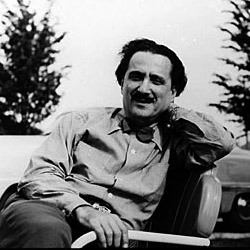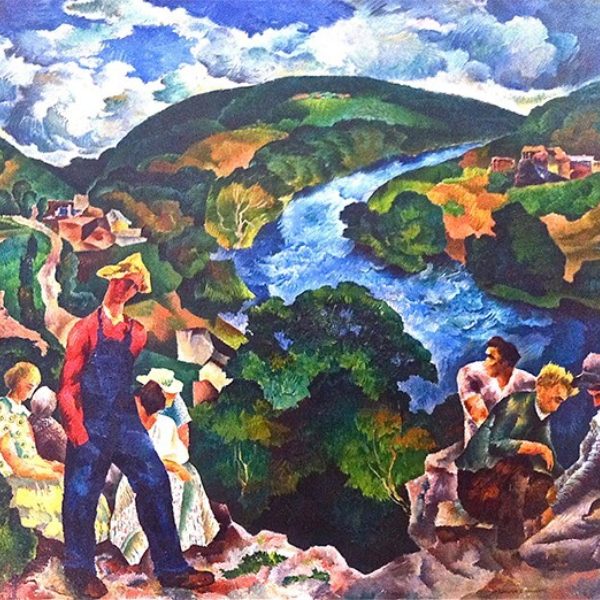
William S. Schwartz
b. 1896, Smorgen, Russia - d. 1977, Chicago, IL
William Schwartz was born in Smorgon, Russia, in 1896, one of nine children in a poor family. He studied art at an early age, earning a scholarship at the Vilna Art School in Russia, 1908–12. He immigrated to the United States at age 17 in 1913, living in New York with his sister for eight months and then moving to Omaha, Nebraska, to live with his brother in 1915. Working as a house painter, he turned his attention to art, studying briefly with J. Laurie Wallace at the Kellom School in Omaha before moving to Chicago. He entered the School of the Art Institute of Chicago (SAIC) in 1916, studying with Ivan Trutnev and Karl A. Buehr, and graduating with honors in life drawing, portraiture, and painting in 1917. He supported himself as a tenor singer in vaudeville, concerts, and opera and received favorable reviews, but he chose to pursue painting instead of singing. His circle of artist friends included important Chicago modernists Aaron Bohrod, Malvin and Ivan Albright, Archibald Motley Jr., and Anthony Angarola. Angarola and Schwartz shared a studio for several years. Schwartz was given a solo exhibition at the Art Institute in 1926—a major accomplishment for 30-year-old artist—his first of three solo exhibitions there. It launched his successful career.
Schwartz established his own style of modernism, influenced by European modernists and American painter Arthur B. Davies. In the catalogue for a second solo show at the Art Institute in 1929, critic J. Z. Jacobsen praised Schwarz’s “powerful and rhythmic lithographs,” and observed that, “Schwartz is also a singer of note, and with this in mind one can more fully appreciate the weird harmonies and swaying movement of his creations in the realm of visual art.” With his use of bold design and flat color influenced by Gauguin and the stark, Fauve colors of Matisse, Schwartz’s works often challenged audiences. Although contemporary writers made efforts to define him as a romanticist rather than an American scene painter, his blend of naturalism and cubism—as seen in Village Number One and Gas Factory, Chicago, for examples—and especially his choice of everyday subject matter suggest an affinity with American scene school. He combined personal allegories and histories with an appreciation of industry and technology.
During the Depression, Schwartz was supported by the Federal Art Project. In 1933, he painted a mural titled Mining for the Century of Progress Exposition; in 1935, he produced a mural entitled Chicago for the Cook County Nurses’ Home, and one called American Musicians for the Glencoe Public Library. He was awarded WPA commissions, and completed murals for Illinois post offices in Fairfield, Eldorado, and Pittsfield. His Mural Study, 1935, for the post office in Pittsfield, shows his approach to constructing a scene that is both decorative and descriptive. Its bold colors and dramatic sky balance the grand span of the bridge and wide river below with a riverboat gliding below it. Family Picnic echoes this river view, situating a motley group of picnickers in the foreground. Schwartz used high-keyed colors and cubist-derived angular shapes to fill in the broad, curved hills on the horizon.
Lisa Meyerowitz
References
Chicago Paintings, 1895–1945: The Bridges Collection. Essays by Wendy Greenhouse and Susan Weininger. Springfield: Illinois State Museum and University of Illinois Press, 2004.
Hall, Michael D., and Pat Glascock. Great Lakes Muse: American Scene Painting in the Upper Midwest, 1910–1960. Flint, MI: Flint Institute of Arts, 2003.
The Paintings, Drawings, and Lithographs of William S. Schwartz (1896–1977). Essay by Douglas Dreishpoon. New York: Hirschl and Adler Galleries, 1984.
Schwartz, William S. Pamphlet P15336. Ryerson Library. The Art Institute of Chicago.
Yochim, Louise Dunn. Role and Impact: The Chicago Society of Artists, pp. 271–72. Chicago: Chicago Society of Artists, 1979.
Artist Image: William Schwartz, ca. 1950 / unidentified photographer. William S. Schwartz papers, Archives of American Art, Smithsonian Institution.

